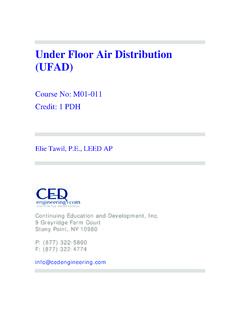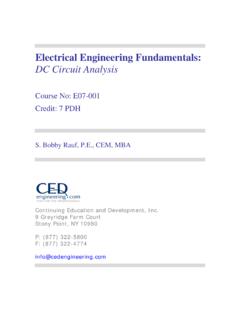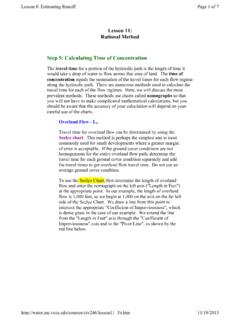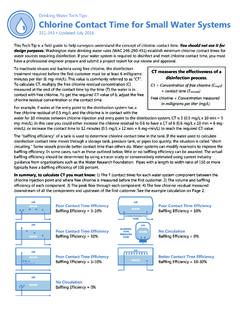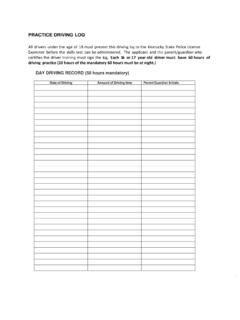Transcription of Rational Method Hydrologic Calculations with Excel
1 Rational Method Hydrologic Calculations with Excel Course No: C01-010. Credit: 1 PDH. Harlan H. Bengtson, PhD, Continuing Education and Development, Inc. 22 Stonewall Court Woodcliff Lake, NJ 07677. P: (877) 322-5800. Rational Method Hydrologic Calculations with Excel Harlan H. Bengtson, PhD, COURSE CONTENT. 1. Introduction Calculation of peak storm water runoff rate from a drainage area is often done with the Rational Method equation (Q = CiA). Use of Excel spreadsheets for Calculations with this equation and for determination of the design rainfall intensity and the time of concentration of the drainage area, are included in this course. The parameters in the equations are defined with typical units for both and units. Image Credit: Virginia Cooperative Extension 2. Learning Objectives At the conclusion of this course, the student will Know the parameters and their and units to be used in the Rational Method equation Be able to calculate peak storm water runoff rate with the Rational Method equation, using either or units Be able to place a given soil into one of the four SCS soil groups based on its measured minimum infiltration rate Be able to place a given soil into one of the four SCS soil groups based on its description Be able to determine a value of the Rational Method runoff coefficient based on land use, soil group.
2 And slope of the watershed Be able to calculate the overland sheet flow travel time for a watershed using the Manning Kinematic equation Be able to calculate the shallow concentrated flow travel time for a watershed using the NRCS Method Be able to calculate the open channel flow travel time for a watershed using the Manning equation Know the form of the equation used for rainfall intensity as a function of storm duration for a specified return period. Be familiar with methods for using Excel spreadsheets to make the types of Calculations discussed in this course. 3. Topics Covered in this Course I. The Rational Method Equation II. Runoff Coefficients III. Watershed time of Concentration IV. Design Rainfall Intensity V. Peak Storm Water Runoff Rate Calculations VI. Summary VII.
3 References 4. The Rational Method Equation The Rational Method equation actually used to calculate peak storm water runoff rate is: Q = CiA ( units), or Q = CiA ( units) where: A = the area of the watershed (drainage area) that drains to the point for which the peak runoff rate is needed (acres for units) (ha for units). C = runoff coefficient for drainage area A. A physical interpretation is the faction of rainfall landing on the drainage area that becomes storm water runoff. (dimensionless for both and units). i = the intensity of the design storm for peak runoff calculation (in/hr for units) (mm/hr for units). Q = the peak storm water runoff rate from the drainage area, A, due to the design storm of intensity, i. (cfs for units) ( m3/s for units). Explanation of Units: For the SI version of the equation (Q = CiA), the factor is needed to convert ha to m, mm to m, and hr to sec as follows: Q = (mm/hr)(ha)(10,000 m2/ha)(1 m/1000 mm)(1 hr/3600 sec), or Q = CiA, with i in mm/hr, A in ha, and Q in m3/s At first glance the units don't appear to be correct for the specified units.
4 The equation actually gives Q in acre-in/hr. The conversion factor, however, is cfs/(acre-in/hr), and based on the precision with which the runoff coefficient can be determined, this conversion is typically taken to be 1, thus giving Q in cfs for rainfall intensity in in/hr and drainage area in acres. The calculation of peak storm water runoff rate from the equation, Q = CiA, is quite straightforward if values are known for C, i, and A. Values for the drainage area, A, and the runoff coefficient, C, can typically be obtained without much trouble. Determination of the design rainfall intensity, i, usually requires the most effort. Example #1: Calculate the peak stormwater runoff rate from a watershed of 15 acres, with a runoff coefficient of , from a storm of intensity in/hr. Solution: This requires simply substituting into the equation ( Q = CiA ), thus: Q = ( )( )(15) = cfs 5.
5 Rational Method Runoff Coefficients Since the physical interpretation of the runoff coefficient is the fraction of the rainfall on the watershed that becomes surface runoff, it must have a value between one and zero. The value of the runoff coefficient for a given drainage area depends primarily on three factors: i) the soil type, ii) the land use, and iii) the slope of the watershed. Each of those factors will now be discussed briefly. Soil Type: Sandy soils allow a high infiltration rate, so they have a relatively low storm water runoff rate and a relatively low runoff coefficient. Soils with a large clay content, however, have a low infiltration rate. As a result, they have a relatively high storm water runoff rate and a relatively high runoff coefficient. The United States Soil Conservation Service (SCS) has identified four soil group classifications (A, B, C, or D) that can be used to help in determining values for drainage area runoff coefficients.
6 Determination of which SCS. soil group fits a particular soil may be on the basis of a measured minimum infiltration rate for the soil or on the basis of a description of the soil. The minimum infiltration rates (from ref #1) for each of the SCS soil groups are as follows: Group A in/hr Group B in/hr Group C in/hr Group D 0 in/hr Descriptions of the four SCS soil groups (from ref #1) are as follows: Group A Deep sand; deep loess; aggregated soils Group B Shallow loess; sandy loam Group C Clay loams; shallow sandy loam; soils low in organic content; soils usually high in clay Group D Soils that swell significantly when wet; heavy plastic clays; certain saline soils Land Use: Factors related to land use that affect the runoff coefficient are the fraction of the area with impervious cover, like streets, parking lots, or buildings and the extent of vegetative cover, which intercepts surface runoff.
7 Slope: In general, a watershed with a greater slope will have a higher runoff coefficient than one with a lesser slope. The two tables below provide runoff coefficient values in terms of land use and watershed slope for each of the four SCS soil groups. As indicated below, the source for the information in the table is the Knox County Tennessee Stormwater Management Manual (Ref #2 at the end of the course). Source: Knox County Tennessee, Stormwater Management Manual, Source: Knox County Tennessee, Stormwater Management Manual, Example #2: What is the value of the runoff coefficient to be used in Rational Method equation Calculations , for a residential area with acre lots, soil group B, and slope of approximately ? Solution: From Part I of the Runoff Coefficient Table above, C = 6.
8 Watershed time of Concentration Background: The time of concentration doesn't appear directly in the Rational Method equation. It is needed, however, for determination of the design rainfall intensity to use in the Rational Method equation. For a given watershed, the time of concentration is the time required for rainfall landing on the farthest point of the watershed to reach the watershed outlet. The time of concentration should be used as the duration of the design storm for calculating peak storm water runoff rate with the Rational Method equation. This is because a storm of duration less than the time of concentration will never have all of the watershed contributing flow at the same time during the storm. A storm with duration equal to the time of concentration will have the full watershed contributing to the runoff at the outlet, (and thus reach peak flow rate) just before the storm ends.
9 A storm of duration greater than the time of concentration, and the same recurrence interval, will be less intense. Estimating time of Concentration: Many empirical equations are available for calculating time of concentration for a watershed. Three that are in widespread use will be discussed in this course. The Manning Kinematic equation will be discussed for overland sheet flow. The NRCS. Method will be used for shallow concentrated flow. Finally, the Manning equation will be discussed for flow in a channel. The Manning Kinematic equation is shown below for both and units: The parameters and their units in this equation are as follows: t1 is the travel time for overland sheet flow (min for both & systems). n is the Manning roughness coefficient, which is dimensionless (see the table below for Manning Roughness Coefficient values for a variety of surfaces.)
10 L is the length of the flow path (ft. for & m for ). P is the 2 year, 24 hour rainfall depth (in. for & mm for ). S is the ground slope, which is dimensionless (or ft/ft for & m/m for ). Source: Iowa Stormwater Management Manual, Section on time of Concentration, at: 3%20 time %20of% Example #3: What would be the overland sheet flow travel time for a watershed with a path length for overland sheet flow of 75 ft; ground slope of ; Manning roughness coefficient for the flow path of ; and 2yr/24hr rainfall of 5 inches? Solution: Substituting values into the Manning Kinematic Equation for units gives t1 = [ ( *75) ]/[ * ] = min The NRCS Method is recommended by and described in references #3 and #4 (Natural Resources Conservation Service and the Iowa Stormwater Management Manual) for the shallow concentrated flow that normally develops within 100 to 300 feet into the watershed, after overland sheet flow.

